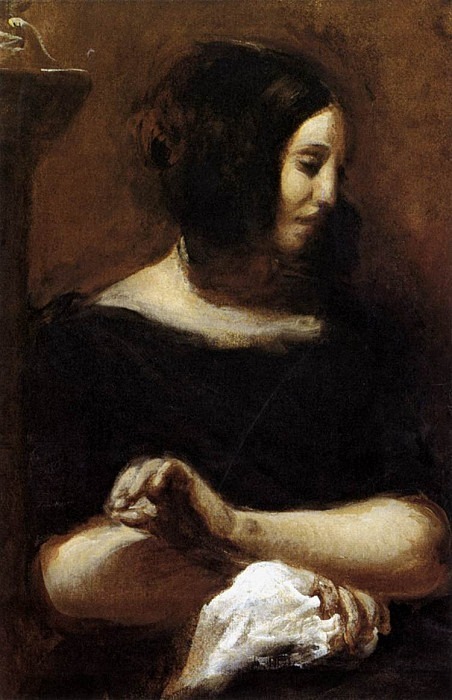George Sand Ferdinand Victor Eugène Delacroix (1798-1863)
Ferdinand Victor Eugène Delacroix – George Sand
Edit attribution
Download full size: 750×1164 px (0,1 Mb)
Painter: Ferdinand Victor Eugène Delacroix
Before us is a fragment of a once entire painting depicting Georges Sand and Frédéric Chopin. Delacroix met the French writer in late 1833, and this meeting resulted in a lasting friendship not without a touch of mutual sympathy. The artist loved the independence of the woman, the resistance on her part to any attempt to impose another’s will. One day, having seen Sand and Chopin together, the artist decided to turn to the genre of portraiture and recreate this meeting on canvas. However, in this form, the picture was not destined to survive for a long time.
Description of Eugène Delacroix’s painting Georges Sand
Before us is a fragment of a once entire painting depicting Georges Sand and Frédéric Chopin. Delacroix met the French writer in late 1833, and this meeting resulted in a lasting friendship not without a touch of mutual sympathy.
The artist loved the independence of the woman, the resistance on her part to any attempt to impose another’s will. One day, having seen Sand and Chopin together, the artist decided to turn to the genre of portraiture and recreate this meeting on canvas.
However, in this form, the picture was not destined to survive for a long time. Greedy owners for the sake of profit decided to unheard of barbarity, cut the picture in half. Thus, one part - with the image of Chopin - is in the Louvre, while the other - with the image of George Sand - is now in Denmark. It is only thanks to the reconstruction that we can understand what the masterpiece originally looked like.
Let’s pay attention to the portrait of the French writer. For Delacroix the norms of academic art were never in the forefront; this is also evident in the portrayal of Georges Sand, which is emphatically expressive. There is a landscape-mood, but, apparently, art historians somewhere miscalculated, not specifying the genre to which this picture belongs - a portrait-mood.
In this case, the painting is not an abundance of bright colors, on the contrary, used by Delacroix tones are very soft, subdued, if I may say so. The mood itself is created in planes inaccessible to the viewer, somewhere in passing.
Perhaps this emotional tension manifests itself in a particular turn of the heroine’s head. Or perhaps the mood is given off by the writer’s involuntarily raised hand. And there is nothing surprising in this kind of immersion of the heroine in herself, because at the moment of her portrayal to the woman came almost the greatest thing that ever existed on earth - Chopin’s music.
Кому понравилось
Пожалуйста, подождите
На эту операцию может потребоваться несколько секунд.
Информация появится в новом окне,
если открытие новых окон не запрещено в настройках вашего браузера.
You need to login
Для работы с коллекциями – пожалуйста, войдите в аккаунт (open in new window).




















You cannot comment Why?
Here we see a deliberate use of chiaroscuro; the strong contrast between light and dark emphasizes the woman’s face and hands while obscuring much of her surroundings. This technique draws attention to these elements as key indicators of her emotional condition. The lighting is not uniform, but rather falls selectively on parts of her body, creating a sense of drama and highlighting the texture of her skin and clothing.
The artist depicted her in dark attire, which contributes to the overall somber mood. The fabric appears simple and unadorned, further reinforcing an impression of restraint or perhaps even austerity. Her hair is styled in a manner consistent with mid-19th century fashion, neatly arranged but not overly elaborate.
Her hands are central to the composition; they hold a needle and thread, actively engaged in the task of embroidery. This activity could be interpreted as symbolic of domesticity, patience, or perhaps even a form of quiet rebellion against societal expectations. The meticulous nature of her work contrasts with the apparent sadness conveyed by her expression.
The background is indistinct, almost entirely swallowed by darkness. A hint of architectural detail – possibly a corner of a room – is discernible in the upper left quadrant, but it serves primarily to frame the figure and intensify the feeling of isolation.
Subtly, theres an air of quiet dignity about her posture. She doesn’t appear defeated or broken, but rather absorbed in her thoughts and actions. The painting suggests a complex inner life, hinting at a woman who is both thoughtful and resilient.